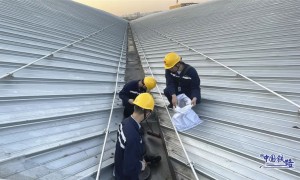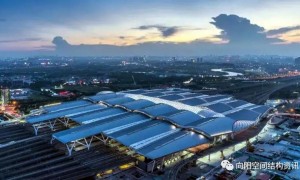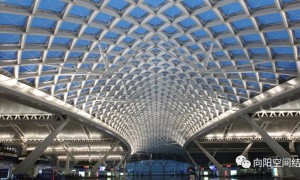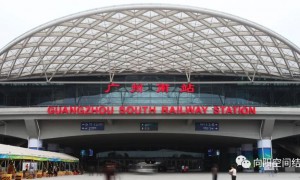Preparing for our prefab future
A burgeoning U.S. prefab market has much to learn from Japan
By Nate Berg
In the Brooklyn Navy Yard, a massive post-military industrial compound of warehouses converted into creative offices and bespoke manufacturing operations, there is a factory that builds houses. It’s a long, cavernous 100,000-square-foot warehouse with a string of workstations for welding together steel-trussed wall panels, threading them with electrical wiring and plumbing, and finishing them off with drywall and window sashes. Stacks of plywood and steel beams fill large racks next to industrial-sized spools of plastic conduit. It’s a construction site gone linear.
在布鲁克林海军造船厂(Brooklyn Navy Yard)里,有一家建造房屋的工厂。这是一个庞大的后军事工业建筑群,由仓库改造而成的创意办公室和定制制造业务。这是一个10万平方英尺的大仓库,里面有一串工作站,用于焊接钢桁架墙板,用电线和管道穿接,最后用干墙和窗框来完成。一堆堆胶合板和钢梁填满了紧挨着工业用塑料导管的大架子。这是一个线性的建筑工地。
Not long ago this factory was used to fabricate the 930 steel-frame modules that were stacked and interconnected to create 461 Dean, a 32-story, 363-unit residential building that opened in 2016 adjacent to the Barclays Center arena in Brooklyn. It’s considered the world’s tallest building built through modular construction, a form of off-site construction that uses nearly finished sections of rooms and units that are built in a factory and snapped together at the construction site. Originally, 461 Dean was supposed to be one of 15 modular buildings in the 22-acre Pacific Park megaproject, but conflict between the developer, Forest City Ratner, and its construction partner, Skanska, stretched construction time to more than four years, wiping out the savings in cost and time and pushing the developer to fall back on conventional construction for the rest of the project. Immediately after construction on the building was finished, Forest City Ratner sold the factory and all its associated technology.
不久前,这家工厂被用来制造930个钢框架模块,这些模块被堆叠并相互连接,从而创建了461栋迪安(Dean)住宅大楼,这是一栋32层、363个单元的住宅建筑,于2016年开业,毗邻布鲁克林的巴克莱中心(Barclays Center)体育馆。它被认为是世界上最高的建筑,通过模块化建造,一种非现场建造的形式,使用几乎完成的部分的房间和单元,在工厂建造,并在施工现场拼接在一起。最初,461dean应该是一个模块化的建筑占地22英亩的太平洋公园超大项目,但开发人员之间的冲突,森林城市拉特纳,及其建设合作伙伴,Skanska延伸建设四年多的时间,擦出节省成本和时间,将开发人员依靠传统的建设项目。这座建筑完工后,森林城的拉特纳立即出售了这家工厂及其所有相关技术。
They didn’t have to look far for a buyer. Roger Krulak was an executive at the company who led the Brooklyn project, and he thought the factory-based building approach could still work. The key was bringing the process under one roof—break down the lines between design, development, and construction, and the delays they saw on 461 Dean would disappear. “Complete inefficiency. That’s what’s wrong with construction,” says Krulak, a 25-year veteran of the industry, as he walks the factory floor.
他们没费多大力气就找到了买家。Roger Krulak是领导布鲁克林项目的公司高管,他认为基于工厂的建造方法仍然可行。关键是把整个过程放在一个屋顶下——打破设计、开发和施工之间的界限,他们在461 Dean上看到的延迟将会消失。“完整的低效率。这就是建筑业的问题所在,”在工厂工作了25年的Krulak如是说。
Krulak became familiar with prefabrication while studying management in Japan in the 1990s, when he toured factories of some of the country’s major prefab homebuilders. Seeing how their systematized factory methods made construction faster, more resource-efficient, and potentially cheaper than conventional building, he knew he wanted to try to replicate Japan’s success back in the U.S. His company, Full Stack Modular, is now operational and focusing on 10- to 45-story buildings, with current projects ranging from a hotel to a mid-rise housing project in Brooklyn to an 11-story building in Manhattan. “We are trying to do it differently and we think we have the model to do it differently,” he says.
上世纪90年代,Krulak在日本学习管理时,熟悉了预制构件,当时他参观了日本一些主要预制房屋建筑商的工厂。看到他们的系统化的工厂方法使建设更快、更多的资源,并有可能低于传统建筑,他知道他想复制日本年代成功回到他的公司在美国,完整的堆栈模块,现在操作和专注于10 – 45层高的建筑,目前工程从酒店到中高层的住房项目在布鲁克林11-story建筑在曼哈顿。他说:“我们正在尝试以不同的方式来做这件事,而且我们认为我们已经有了以不同方式来做这件事的模式。”
Differently for the U.S., at least. This approach to construction is becoming almost mainstream in many parts of the world—from Sweden to Germany to Australia. But the world leader in prefabricated housing is undoubtedly Japan. More than 15 percent of the nearly 1 million new homes and apartments built there last year were made inside factories, either as stackable modular blocks or panelized walls and floors pieced together on empty lots. Millions of buildings now standing in Japan were prefabricated, and several Japanese companies regularly produce more than 10,000 new prefab homes every year. “They’re leap years ahead of where we’re at today,” Krulak says.
美国的情况则有所不同。,至少。从瑞典到德国,再到澳大利亚,这种建筑方式在世界许多地方几乎已成为主流。但毫无疑问,预制装配式房屋的世界领导者是日本。去年在那里建造的近100万套新住宅和公寓中,超过15%是在工厂里建造的,要么是可堆叠的模块块,要么是在空地上拼装的镶板墙和地板。在日本,数以百万计的建筑物是预制的,一些日本公司每年定期生产超过10,000套新的预制房屋。Krulak说,它们比我们今天所处的位置提前了好几年。
In the U.S., only a small number of homes are prefabricated (not counting mobile, or “manufactured,” homes). Annually, only about 2 percent of new single-family homes are constructed through modular means, according to the U.S. Census. Even so, off-site construction has long been seen as the grand solution for the mass production of affordable homes. Everyone from Frank Lloyd Wright to Buckminster Fuller has tried to make a go of industrialized housing in the U.S., particularly after World War II, with startups using mothballed aircraft factories for production. Though a few, like the Lustron Corporation, managed to produce a couple thousand prefab homes here and there, none of these ventures achieved their goal of revolutionizing the production of housing.
在美国在美国,只有一小部分房屋是预制的(不包括流动房屋或人造房屋)。根据美国人口普查局(U.S. Census)的数据,每年只有大约2%的新单户住宅是通过模块化方式建造的。即便如此,场外建设一直被视为大规模生产经济适用房的伟大解决方案。从弗兰克·劳埃德·赖特(Frank Lloyd Wright)到巴克明斯特·富勒(Buckminster Fuller),所有人都试图在美国建造工业化住宅特别是第二次世界大战后,初创公司使用封存的飞机工厂进行生产。尽管像Lustron公司这样的少数几家公司,成功地在各处生产了几千套预制房屋,但没有一家公司实现了彻底改革住房生产的目标。
Krulak thinks prefab’s time may have finally come in the U.S. With advanced robotics, automation, and digital building information technologies—and increasing concern nationwide about the affordability of urban housing—factory-built housing once again seems poised for wider adoption. And a growing number of companies, from small homebuilders to major hoteliers, are betting that prefab is the future. To understand what that future may look like, you have to go to Japan.
Krulak认为,随着先进的机器人技术、自动化技术和数字建筑信息技术的出现,预制装配式房屋在美国的时代可能终于到来了,而全国范围内对城市住宅工厂建造住房的可负担性的日益担忧似乎将再次得到更广泛的采用。从小型房屋建筑商到大型酒店运营商,越来越多的公司都在押注预制板就是未来的趋势。要了解未来会是什么样子,你必须去日本。
Half of a dining room creeps slowly along a conveyor on a factory floor, with holes where its windows will soon be installed and bundles of electrical wire waiting to be connected with the room’s other half. That chunk is following closely behind on the assembly line, along with a few dozen segments of houses—bathrooms, bedrooms, sections of living rooms—each a box of walls, ceilings, and floors inside a steel frame, as if a typical house had been sawed into precise geometrical forms.
“Right now, you’re looking at units for the homes of two or three different customers,” says Toshiya Nomura, a factory boss for Sekisui Heim, the house-building segment of the Sekisui Chemical Company, a Japanese conglomerate that’s one of the largest prefabricated-home manufacturers in the world. We’re standing on a catwalk looking down on the assembly line at Sekisui Heim’s factory in the city of Hasuda, about 25 miles north of Tokyo, where the house parts glide through a series of workstations of robots spot-welding metal beams and rotating wall panels, workers nailing together staircases and slotting in sliding glass doors. In the same light blue uniform worn by the nearly 500 workers clanging away below, Nomura explains through an interpreter that this factory is one of eight the company operates across Japan and that it has the capacity to produce about 150 of these box-like modules per day, the equivalent of about 10 homes. Overall, the company produces about 14,000 houses and apartments per year.
目前,你正在为两三个不同客户的住宅寻找单元,日本Sekisui化工公司(Sekisui Chemical Company)的住宅建筑部门Sekisui Heim的工厂老板野村敏也(Toshiya Nomura)说。该公司是全球最大的预制房屋制造商之一。我们站在时装表演在流水线上下来看着Sekisui海姆年代工厂在Hasuda,东京以北25英里,那里的房子部分滑行通过一系列点焊机器人工作站的金属横梁和旋转墙面板、工人钉在一起的楼梯和开槽滑动玻璃门。在相同的浅蓝色制服穿的近500工人发出叮当声的下面,野村证券通过翻译解释说,这个工厂是八个公司经营日本和它的生产能力约150每天这些盒子造型模块,相当于大约10家。总体而言,该公司每年生产约1.4万套住宅和公寓。
Sekisui Heim, along with about a dozen other major manufacturers, now produces about one of every six new homes built in Japan annually. Prefabricated housing is common in Japan, from multi-unit apartments in Tokyo to modest bungalows in far-out villages to expansive luxury homes in the suburbs. The industry emerged partly by happenstance in the aftermath of the destruction of World War II. In the early 1950s, when Japan was still under Allied occupation and the Korean War was raging, the U.S. military’s demand for steel caused a boom in Japanese industry. After that conflict ended, the companies running those factories began looking for new markets. With the need for housing acute—Japan faced a shortfall of 4.2 million homes in the postwar years—and the population growing, and with the government offering incentives for housing construction, some began building homes. “The growth of the prefabricated housing industry mostly had to do with timing,” says Shuichi Matsumura, a professor of architecture at the University of Tokyo and an expert on prefabricated housing.
Sekisui Heim与其他十几家主要制造商一道,目前每年在日本建造的新房中,约有六分之一是由该公司生产的。预制房屋在日本很常见,从东京的多户型公寓到偏远村庄的普通平房,再到郊区的豪华住宅。这个行业的兴起部分是由于二战结束后的偶然事件。在20世纪50年代早期,当日本还处于盟军占领和朝鲜战争肆虐的时候,美国军方对钢铁的需求导致了日本工业的繁荣。冲突结束后,运营这些工厂的公司开始寻找新的市场。由于对住房的迫切需求,战后日本面临着420万套住房的短缺和人口的不断增长,而随着政府为住房建设提供激励,一些人开始建造住房。东京大学(University of Tokyo)建筑学教授、装配式房屋专家松村修一(Shuichi Matsumura)说,装配式房屋行业的增长主要与时机有关。
What followed was a boom in homebuilding—both among prefab manufacturing companies and the far more plentiful independent carpenters and builders—growing from about 688,000 new housing starts in 1963 to more than 1.9 million a decade later. Since then, Japan has had an unusually high rate of new homebuilding, much of which can be attributed to the fact that Japanese homes depreciate quickly, losing all of their value within 20 to 30 years. When property changes hands, valueless homes are typically torn down and built anew. This scrap-and-build approach has a few interrelated causes: the short lives of low-quality postwar construction; the challenges of renovating to meet building code revisions meant to address Japan’s seismic activity; a feedback loop of poor maintenance resulting from the lack of a resale market. The result is that Japan builds approximately the same amount of new housing each year as the U.S., a country with three times the population.
随之而来的是预制制造业公司和数量多得多的独立木匠和建筑商的房屋建设热潮,从1963年的约68.8万套新屋开工,到10年后的逾190万套。从那以后,日本的新屋开工率异常之高,这在很大程度上可以归因于日本房屋的快速贬值,在20至30年内就失去了所有的价值。当财产易手时,毫无价值的房屋通常会被推倒重建。这种“以旧换新”的做法有几个相互关联的原因:低质量的战后建筑寿命短;改造的挑战,以满足建筑法规的修订意味着解决日本的地震活动;由于缺乏转售市场而形成的维护不良的反馈循环。结果是,日本每年新建的住房数量与美国大致相当这个国家的人口是美国的三倍。
Prefab home builders, like car manufacturers, have taken advantage of this scrap-and-build mentality, continually producing new models of homes with added features and updated safety standards. (A television ad for Sekisui Heim shows an elephant standing safely on top of one of its steel-frame modules. Another shows a frame being dropped from a crane.) According to Matsumura’s research, prefab buildings made up about 7 percent of new homes in the early 1970s. By 2016, they accounted for more than 15 percent.
与汽车制造商一样,预制房屋建筑商也利用了这种“以旧换新”的心态,不断推出具有附加功能和更新安全标准的新型房屋。(Sekisui Heim的一则电视广告显示,一头大象安全地站在它的一个钢架模块上。另一幅画展示了一个框架从起重机上掉下来。)根据Matsumura的研究,在20世纪70年代早期,预制房屋占新住宅的7%。到2016年,这一比例已超过15%。
But conditions are changing. The amount of new housing being built in Japan is slowly declining, as is the country’s population, which is expected to shrink from about 127 million today down to 88 million by 2065. Twenty years from now, more than a third of the population will be 65 or older, and both old and young are already concentrating into metropolitan areas, leaving millions of suburban and rural homes vacant. And with a stagnant economy, the demand for new homes is evaporating.
但情况正在改变。日本正在建设的新住宅数量正在缓慢下降,该国的人口也在下降。预计到2065年,日本人口将从目前的1.27亿左右减少到8800万。20年后,超过三分之一的人口将达到或超过65岁,老老少少都已经集中在大都市地区,留下数以百万计的郊区和农村住宅空置。在经济停滞的情况下,对新房的需求也在减少。
The country’s prefab manufacturers aren’t waiting for the changing demographics to run them out of business. Instead, they’re doubling down on the design and development of new products to lure in a larger share of a shrinking market, through customizable and flexible home designs, additional luxury appliances and features, and, given the country’s predisposition to natural disasters, advanced safety measures.“Welcome to the dream factory,” says a man at the front of a theater. He’s in a uniform embroidered with the logo of Sekisui House, Japan’s biggest prefabricated home manufacturer, and the theater is part of a factory and showroom complex in Koga, an industrial city about an hour outside of Tokyo. He starts a film, which uses one of the company’s homes as its set. A multigenerational family is preparing for a potluck. The camera swoops through the house, its kitchen, and out to its patio, where a grandfather is showing his grandson lush crops from the home’s small vegetable garden. As guests arrive, the camera zooms out to show a leafy neighborhood of pristine homes lined around a central green—each a Sekisui House product. Suddenly, the theater’s screen raises like a curtain to reveal a large opening to the outdoors, onto the very cluster of homes featured in the film. The man in the uniform smiles.
该国的预制装配式汽车制造商并没有坐等人口结构的变化让他们破产。相反,他们正在加倍投入新产品的设计和开发,以吸引更大的市场份额,通过可定制和灵活的家居设计,额外的豪华电器和功能,以及考虑到日本易受自然灾害的影响,先进的安全措施。“欢迎来到梦工厂,”剧院前的一名男子说。他穿着一件绣有Sekisui House标志的制服,Sekisui House是日本最大的装配式住宅制造商。这家剧院是古贺市(Koga)一家工厂和展示厅的一部分。古贺市是一个工业城市,距离东京约一小时车程。他以公司的一处住宅为背景,开始了一部电影。一个多代同堂的家庭正在准备聚餐。镜头掠过房子、厨房,一直拍到院子里,一位祖父正在给孙子看自家小菜园里郁郁葱葱的庄稼。随着客人的到来,镜头拉近,呈现出一片绿树成荫的原始住宅社区,围绕着中心绿地排列,每一个都是Sekisui住宅的产品。突然间,影院的屏幕像窗帘一样升起,向外打开了一个巨大的开口,映入电影中出现的一群群家庭。那个穿制服的人笑了。
The model homes on display in this theater/exhibition space are some of Sekisui House’s top-line products. Replacing shoes with slippers in the foyer, visitors can walk through these furnished show homes, each offering a stylistic theme—from the sleek slate facade and floor-to-ceiling windows of a modernist bachelor pad to the peaked roofline of a suburban McMansion to the indoor-outdoor fluidity of a California Contemporary that could host a summer potluck. Each was fully fabricated in the Sekisui House factory down the road.By signing up, you agree to our Privacy Notice and European users agree to the data transfer policy.
在这个剧场/展览空间中展出的样房是Sekisui House的一些顶级产品。更换鞋子和拖鞋在门厅,游客可以穿过这些家具显示房屋,每个提供光滑的石板立面的风格主题和落地窗的现代单身公寓)的郊区豪宅的室内外流动性加州当代夏天举办一个聚会。每一个都是在街尾的Sekisui House工厂完全组装的。通过注册,您同意我们的隐私通知和欧洲用户同意数据传输政策。
In hundreds of locations across the country, often in suburban areas, model homes like these are on display in what are known as housing plazas—outdoor showrooms with full-scale model homes and salespeople eager to offer tours. Big prefab manufacturers like Sekisui House and Daiwa House line their homes up on fake neighborhood blocks alongside model homes from smaller-scale prefab manufacturers like TamaHome and local conventional builders. The homes are bigger than what most people would need, in order for the housing companies to show all the options available.
在全国各地的数百个地方,通常是在郊区,像这样的样板房在所谓的住房广场上展出,那里有全尺寸的样板房和急于提供参观服务的销售人员。Sekisui House和大和房建(Daiwa House)等大型预制房屋制造商在假街区上排列房屋,旁边是TamaHome等规模较小的预制房屋制造商和当地传统建筑商的样板房。这些房子比大多数人需要的都要大,以便让房地产公司展示所有可用的选择。
Safety features and seismic reinforcements are an inevitable part of the walkthrough: Walls and floors are often sliced open and covered with transparent plastic to show sturdy steel beams and cross bracing. High-end appliances and built-in features bedeck every room possible. Typical prefab homes in Japan cost usually in the $300,000s, comparable to conventionally built houses, Matsumura says. These new high-end features are pushing them to higher price points.
安全设施和抗震加固是走道不可避免的一部分:墙壁和地板经常被切开,并用透明塑料覆盖,以显示坚固的钢梁和交叉支撑。每一个房间都配备了高端电器和内置功能。Matsumura说,在日本,典型的预制房屋的价格通常在30万美元左右,与传统的房屋价格相当。这些新的高端功能将它们推向了更高的价位。
One of the bigger housing plazas is located about an hour by train from Tokyo, in a suburb called Tachikawa. About 50 homes are on display here, and a slow trickle of shoppers mills around on a recent Sunday afternoon. Mikiko Okabe, her husband, and her parents have just toured a steel-frame prefab model home built by the company Asahi Kasei. The family is in the market for a duplex they can share. “My parents will live on the ground floor and we will live above,” she says. They decided to look at prefab homes instead of conventional wooden houses because of advertised soundproof floors. “We want to make sure we don’t disturb them,” Okabe says.
其中一个比较大的住宅广场位于东京市郊的立川区,从东京坐火车到这里大约需要一个小时。最近的一个周日下午,这里大约有50户人家在展示商品,购物者在附近的商店里络绎不绝。冈部美纪子(Mikiko Okabe)、她的丈夫和父母刚刚参观了朝日Kasei公司(Asahi Kasei)建造的一套钢框架预制房屋。这家人正在市场上寻找一套可以合租的复式公寓。“我父母住在一楼,我们住在上面,”她说。他们决定看看预制房屋,而不是传统的木制房屋,因为广告中的隔音地板。我们要确保不打扰他们,冈部说。
Nearby, Shoko Yokota is looking at a conventional wooden home. She’s not interested in prefab homes—too basic, she says—and is instead looking for a home in the style of an English manor one might find in the Cotswolds. She’s never been there, she says, but her husband has. “I love the Old World style, the beautiful tiles.”
附近,横田正子(Shoko Yokota)正在看一座传统的木屋。她说,她对预制房屋不感兴趣——太简单了——相反,她要找的是科茨沃尔德(Cotswolds)地区那种英式庄园风格的房子。她说她从未去过那里,但她丈夫去过。“我喜欢旧世界的风格,漂亮的瓷砖。”
Next door, a saleswoman tries to lure Yokota in for another tour by noting that the company’s homes are designed to be furnished by Ikea. “For Scandinavian tastes,” she says.
隔壁的一位女销售员说,公司的房子都是按照宜家(Ikea)的家具设计的,她想以此吸引横田洋子再来一趟。“适合斯堪的纳维亚人的口味,”她说。
It’s a significant shift in focus for the prefabricated housing industry, from its roots as a postwar housing solution for the masses to producing primarily luxury homes for the upper-middle class and above. “For the single-family housing industry to survive, we have to focus on the luxury market,” says Noboru Kaihou, a public information officer for Daiwa House.
预制装配式住宅行业的重心发生了重大转变,从为大众提供战后住房解决方案的根基,转变为主要为中上层阶级及以上人群提供豪华住宅。大和房建的公共信息官Noboru Kaihou说,独栋住宅行业要想生存,我们必须专注于豪华住宅市场。
Bringing down costs isn’t a priority for most of Japan’s prefabricated housing industry, but advances in technology and increasing automation may make homes more affordable anyway. An hour’s train ride from Kyoto is the factory and R&D facility of PanaHome, the prefab homebuilding arm of the electronics company Panasonic, and automation has been integrated into nearly every part of its assembly line. Robots spot-weld steel beams into the panels that are eventually snapped together into homes. A two-level conveyor system pulls the panels along, automatically applying zig-zags of glue and laying down pre-cut interior wall materials. At the end of the row, the conveyor flips the wall panel and sends it back to where other robots and a small team of human workers insert insulation and nail down exterior wall finishes. A five-axis robot arm scans up and down the newly outfitted wall before applying a precise line of sealant in the seams between the exterior panels and around the windows. Elsewhere, another even larger robot arm stacks the completed panels for shipping, layered from top down in the order workers will install them. This factory produces enough panels to build about 16 homes a day.
对大多数日本装配式房屋行业来说,降低成本并不是首要任务,但技术进步和自动化程度的提高可能会让房屋变得更实惠。从京都乘一个小时的火车,就可以到达松下电器公司(Panasonic)的预制房屋建筑子公司PanaHome的工厂和研发中心,其装配线的几乎每一部分都实现了自动化。机器人将钢梁点焊到面板上,最终将面板拼接成房屋。一个两层的输送系统将面板向前拉,自动涂上锯齿状的胶水,并铺上预先切割好的内墙材料。在这一行的最后,传送带将墙板翻转过来,将其送回其他机器人和一小组人类工人插入绝缘材料并钉牢外墙饰面的地方。一个五轴机器人手臂在新安装的墙上上下扫描,然后在外板和窗户周围的接缝处涂上精确的密封胶。在其他地方,另一个更大的机器人手臂堆放着完成的运输面板,按照工人将安装它们的顺序从上到下分层排列。这家工厂生产的太阳能板每天可以建造16个家庭。
On the actual construction site, all the automation results in a very quickly built house. PanaHome officials play a time-lapse video showing one of their homes being constructed on a customer’s plot of land. A small crane unloads panels from the back of a truck as workers guide walls and floors down onto a pre-poured concrete foundation. Within an hour and a half, the first floor is complete. A few truckloads later, the whole house is built, floor to roof, in just five hours. (The process typically takes a full work day; “The workers skipped lunch for the video,” a company official notes.)
在实际的施工现场,所有的自动化导致一个非常快建成的房子。PanaHome的工作人员播放了一段延时录像,显示他们的一所房子正在客户的一块土地上建造。一台小型起重机从卡车后部卸下面板,工人将墙壁和地板引导到预先浇筑的混凝土地基上。不到一个半小时,一楼就完工了。几辆卡车之后,整个房子从地面到屋顶只用了5个小时就建成了。(这个过程通常需要整整一个工作日;一位公司管理人员说,工人们因为视频而没有吃午饭。)
The overall process for building a PanaHome takes three to four months, involving accommodating a customer’s specific design requirements plus the time to permit the project, demolish any pre-existing building, lay a new foundation, and install finishings inside the completed structure. Though the average cost for a prefab home like this is comparable to conventional construction, the home can be move-in ready in half the time or less. For prefab builders, the speed of construction is a strong selling point.
建造PanaHome的整个过程需要三到四个月的时间,包括满足客户的具体设计要求,以及允许项目的时间,拆除任何现有的建筑,铺设新的地基,并在完成的结构内安装装修。虽然这种预制房屋的平均成本与传统建筑相当,但只需一半或更少的时间就可以搬进来。对于预制建筑商来说,施工速度是一个强大的卖点。
“On-site construction of prefabricated buildings is very easy and skilled workmen are not necessary,” says Junichi Goda, managing director of the Japan Prefabricated Construction Suppliers and Manufacturers Association. He says that the companies in the association are all looking at how improving the efficiency of the production process can improve the efficiency of construction. He predicts that automation will become even more prevalent in the years to come.
“预制装配式建筑的现场施工非常容易,不需要熟练工人,”日本预制装配式建筑供应商和制造商协会(Japan pre装配式建筑供应商和制造商协会)常务董事Junichi Goda表示。他说,协会的所有公司都在研究如何提高生产过程的效率,从而提高建筑的效率。他预测,自动化将在未来几年变得更加普遍。
And it may have to. “A major issue in Japan today is the rapid decrease of carpenters,” says Matsumura, the prefab housing expert. In the 1980s, he says, there were about 1 million skilled carpenters in Japan, using traditional joinery and construction techniques to build the roughly three-quarters of homes in the country that are not in some way prefabricated. Now, there are only about 300,000 of these carpenters, and their numbers continue to fall. (In the U.S. there are currently more than 2.5 million people employed in residential construction jobs.) Japanese prefab manufacturers, with their quality control and factory precision, have become a more attractive option in a smaller field of builders.
而且它可能不得不这样做。预制房屋专家Matsumura说,如今日本的一个主要问题是木匠的快速减少。他说,上世纪80年代,日本大约有100万名熟练木匠,他们使用传统的细木工和施工技术建造了日本约四分之三的房屋,这些房屋在某种程度上不是预制的。现在,只有大约30万名木匠,他们的数量还在继续下降。(在美国,目前有超过250万人从事住宅建筑工作。)日本预制件制造商凭借其质量控制和工厂精度,在较小的建筑商领域成为更有吸引力的选择。
Architecturally, that may mean an increasingly disjointed urban landscape, according to Azby Brown, director of the Kanazawa Institute of Technology’s Future Design Institute in Tokyo, who’s written extensively about Japanese homebuilding and architecture. “The prefab companies pride themselves on their ability to provide whatever style people want,” he says, “but often they don’t really mesh with their surroundings, or with the traditional urban form.” Prefab buildings are typically standalone single-family homes, unlike traditional Japanese buildings that align their facades to create an almost seamless engagement with the street. “Let’s call it a lack of contextual awareness,” he says. “I guess it’s because the market hasn’t asked for it.”
在建筑学上,这可能意味着一个日益脱节的城市景观,根据Azby Brown的观点,他是东京金泽技术学院未来设计院的主任,他写了大量关于日本住宅建设和建筑的文章。他说,预制装配式公司为自己有能力提供人们想要的任何风格而自豪,但它们往往与周围环境或传统的城市形式并不合拍。预制建筑通常是独立的单户住宅,不像传统的日本建筑,它们的外立面与街道几乎无缝连接。我们姑且称之为情境意识的缺乏,他说。我想这是因为市场并不需要它。
That could be changing. Some companies and designers are now starting to think differently about the potential of prefabrication, with design as the guiding principle. The minimalist retailer Muji has recently ventured into homebuilding, and has used prefabrication for projects or parts of projects. Known for its plain aesthetic and focus on utilitarianism, Muji began selling homes in 2004, partnering with architects like Kengo Kuma to create prototype homes of Muji-like simplicity. These designs became the basis for industrialized versions, with three models that can be adjusted to customers’ spatial needs and produced in factories. (The company recently expanded its offerings with the Muji Hut, a 130-square-foot one-room cabin marketed as a sleek halfway point between camping and a vacation home.)
这种情况可能正在改变。一些公司和设计师现在开始以设计为指导原则,以不同的方式思考预制的潜力。极简主义零售商无印良品(Muji)最近进入了住宅建筑领域,并在项目或部分项目中使用了预制构件。Muji以朴素的美学和注重实用主义而闻名,2004年开始出售房屋,与隈研吾(Kengo Kuma)等建筑师合作,创造出Muji式简单的房屋原型。这些设计成为工业化版本的基础,有三种模型可以根据客户的空间需求进行调整,并在工厂生产。(该公司最近又推出了无印良品小屋(Muji Hut),这是一间130平方英尺的单间小屋,被宣传为介于露营和度假屋之间的时尚小屋。)
So far, the company has sold about 2,000 of its prefabricated houses. “Muji doesn’t intend to do mass housing,” says Koji Kawachi, a registered architect and director of Muji House, the subsidiary company charged with designing and selling Muji’s homes (and huts). He’s leading a tour through a model of the Wood House, outside of Yokohama. The house is a white, two-story rectangular building with floor-to-ceiling windows lining nearly its entire length and wrapped with a ground-floor porch. Inside, it’s filled with natural light from the large wall of windows, and it is surprisingly open for a two-story, two-bedroom home of about 1,100 square feet. “It looks completely different from conventional Japanese houses,” Kawachi says.
到目前为止,该公司已售出约2,000套装配式房屋。无印良品的注册建筑师兼子公司无印良品之家(Muji House)的董事Koji Kawachi说,无印良品不打算建造大规模住宅。无印良品之家负责设计和销售无印良品的房屋。他正在带领一个旅行团参观横滨郊外的木房子模型。这栋房子是一座白色的两层矩形建筑,从地板到天花板的窗户几乎沿着整座房子的长度排列,房子的底层有一个门廊。在室内,它充满了来自巨大的窗户墙壁的自然光,对于一个大约1100平方英尺的两层两卧室的住宅来说,它是惊人的开放。它看起来完全不同于传统的日本房子,Kawachi说。
The openness is deliberate. The home was designed without full walls separating any of its spaces, save the bathroom. From the second-floor master bedroom, one can look down on the living room and kitchen or across to the other bedroom. It’s partly for energy-efficiency reasons—the lack of walls makes it easier to heat and cool—but mostly an attempt at social engineering. “It makes the bond of the family stronger because each member is not isolated from one another,” Kawachi says. “We’re making a proposal for a new lifestyle for the Japanese people.”
这种开放是经过深思熟虑的。住宅的设计没有完全的墙壁分隔任何空间,除了浴室。从二楼的主卧可以俯瞰起居室和厨房,也可以俯瞰另一间卧室。这部分是由于节能的原因,墙壁的缺乏使它更容易加热和冷却,但主要是一个社会工程的尝试。Kawachi说,这使家庭的纽带更加牢固,因为每个成员之间并不是孤立的。我们正在为日本人民的新生活方式提出建议。
The design is also flexible, he says, noting that as family makeup changes and children grow, walls can easily be added or removed to accommodate new needs—something the typical home is unable to do. Standardized designs and factory-produced components allow the home to evolve with its owners, and potentially to live on to meet the needs of new owners down the line. “Our dream is for this type of house to become a conventional house,” Kawachi says.
他说,设计也很灵活,随着家庭构成的变化和孩子的成长,墙壁可以很容易地添加或删除,以适应新的需求——这是典型的家庭无法做到的。标准化的设计和工厂生产的组件使房屋与业主共同发展,并有可能继续满足新业主的需求。Kawachi说:“我们的梦想是让这种类型的房子成为一个传统的房子。”
But prefab or partially pre-built homes may make their strongest inroads into the current U.S. housing market as a solution to non-conventional housing needs. In Los Angeles, which has the highest unsheltered homeless population in the U.S., plans were recently released for an 84-unit transitional housing complex for the city’s homeless built using shipping containers, a first for the city. The project’s architects, KTGY, cite the ready-made simplicity of the containers as a key to getting the project built in just six months. For other cities grappling with the slow disasters of homelessness and a lack of access to affordable housing, pre-built elements, like containers, are powerful tools.
但作为非传统住房需求的解决方案,预制或部分预制房屋可能会在当前美国住房市场取得最大的进展。洛杉矶是美国无家可归人口最多的城市在美国,最近公布的计划是,要为无家可归者建造一个由84个单元组成的过渡性住房综合体,使用海运集装箱,这在该市尚属首次。该项目的建筑师KTGY认为,集装箱的现成的简单性是在短短6个月内建成该项目的关键。对于那些正在努力应对缓慢灾难的无家可归者和缺乏负担得起的住房的其他城市来说,预制构件,比如集装箱,是强有力的工具。
Japanese architect Shigeru Ban offers one model for using pre-built construction to design for disaster. After the 2011 tsunami that struck the northeastern coast of Japan, Ban—a Pritzker Prize winner famed for unique cardboard-based shelter structures designed for disaster response in places like Haiti and Rwanda—was called on to help design temporary housing for a particularly hard-hit harbor town named Onagawa. Then home to about 10,000 people and sitting inside a small bay, the town’s hillsides had the unfortunate effect of funneling the tsunami into an even taller onslaught of water, nearly 50 feet high, which rushed inland and tore apart roughly 70 percent of the town’s buildings. An estimated 827 people died.
日本建筑师坂茂(Shigeru Ban)提供了一个模型,用于使用预制建筑来设计灾难。2011年袭击日本东北海岸的海啸发生后,曾获得普利兹克奖(Pritzker Prize)的坂茂受邀为受灾特别严重的港口城市女川(Onagawa)设计临时住所。这座小城坐落在一个小海湾里,约有1万人居住,不幸的是,它将海啸汇集到一个更高的海水中,接近50英尺高,冲到内陆,撕裂了大约70%的城镇建筑。估计有827人死亡。
Ban was tasked with quickly creating 190 temporary housing units, for use by residents as the town recovered and new housing plots could be prepared and distributed by lottery. Lacking suitable flat space for construction, the town’s baseball field was taken over. But the space would have only allowed about 70 of the portable single-story temporary buildings commonly used by the government. Ban proposed a series of rectangular buildings two and three stories tall, built from shipping containers, with interior walls strategically removed to create open spaces and balconies. “My approach solved the problem,” Ban says in his Tokyo office.
坂茂的任务是迅速建立190个临时住房单元,供当地居民使用,因为城镇已经恢复,新的住房地块可以通过抽签的方式准备和分配。由于缺乏合适的建筑场地,镇上的棒球场被接管了。但是这个空间只能容纳大约70个被政府广泛使用的可移动的单层临时建筑。坂茂提出了一系列两层和三层的矩形建筑,由集装箱建造,内墙被战略性地拆除,以创建开放空间和阳台。坂茂在他东京的办公室里说:“我的方法解决了这个问题。”
Ban says the Japanese government is “not as serious as they should be” about disaster readiness in housing. (More than six years after the tsunami, Ban’s temporary units and their residents are still sitting on that baseball field, under the shadow of its scoreboard.) So he has continued preparing new plans on his own. He’s developed a design for temporary housing based on simple factory-fabricated wooden panels that can be trucked to sites in need. They serve as the structural frame of the building, the basic form of which can be assembled in just two days. The design was put into action in July 2016, after a 7.0 earthquake hit the southern prefecture of Kumamoto. By early September, a temporary home was complete and able to accommodate three families. Key to the speed of construction were the prefabricated structural panels. For Ban, they’re an example of how an industrialized approach to building can not just meet the market’s demands, but also answer a serious need.
坂茂说,日本政府并没有像他们应该做的那样认真对待住房方面的防灾准备。(海啸过去六年多了,坂茂的临时住所和他们的居民仍然坐在那个棒球场的记分牌下。)所以他继续自己准备新计划。他开发了一种临时房屋的设计,这种房屋是基于简单的工厂预制木板,可以用卡车运到需要的地方。它们作为建筑的结构框架,其基本形式可以在两天内组装完成。该设计在2016年7月南部熊本县发生7.0级地震后投入使用。到9月初,一个临时住所已经建成,可以容纳三个家庭。施工速度的关键是预制结构板。对于坂茂来说,它们是一个例子,说明工业化的建筑方式不仅能满足市场需求,而且能解决严重的需求。
“I’m interested in designing a system, not designing houses one by one,” Ban says.
“我感兴趣的是设计一个系统,而不是一个接一个地设计房子,”坂茂说。
It’s a sign of the future of factory-built housing that Japan’s highly advanced prefabricated housing industry is diversifying into new forms and market niches. It’s also telling that the Japanese companies are expanding outside of their homeland, pivoting away from a shrinking country and economy and toward a growing and urbanizing world. Most of the major manufacturers are either opening or already operating factories in other countries: Sekisui House now has factories in Australia and China; Daiwa House recently began partnering with local builders in Malaysia; Sekisui Heim began building in Thailand in 2013; PanaHome has fledgling enterprises in Taiwan, Vietnam, Singapore, Malaysia, and Indonesia.
日本高度发达的装配式房屋行业正在向新形式和新市场领域多元化,这是工厂化住宅未来发展的一个迹象。这也说明,日本企业正在向海外扩张,从一个不断萎缩的国家和经济转向一个不断增长和城市化的世界。大多数主要制造商要么在其他国家开设工厂,要么已经在其他国家开设工厂:Sekisui House目前在澳大利亚和中国设有工厂;大和房建最近开始与马来西亚当地建筑商合作;Sekisui Heim于2013年在泰国开始建设;PanaHome在台湾、越南、新加坡、马来西亚和印度尼西亚都有新兴企业。
Some are even edging into the U.S. market. Sekisui House recently purchased the Salt Lake City-based homebuilder Woodside Homes, and in February Daiwa House expanded a small U.S.-based subsidiary by acquiring a majority stake in the single-family homebuilder Stanley Martin, based in the Washington D.C. metro area. Neither are planning to open Japanese-style prefab factories any time soon. Officials from Daiwa House say they’re interested in understanding the U.S. market before making the significant capital investments a factory would require. And given that modular and prefabricated houses are sometimes treated differently from conventional construction in local zoning codes, the regulatory environment of this bigger market is exponentially more complicated.
一些公司甚至逐渐进入美国市场。Sekisui House最近收购了盐湖城(Salt Lake city)的房屋建筑商Woodside Homes,并在今年2月扩大了在美国的一个小型住宅项目总部位于华盛顿特区大都市区的单一家庭住宅建筑商斯坦利·马丁(Stanley Martin)获得了该公司的多数股权。两家公司都没有计划在短期内开设日式装配式工厂。大和房建的管理人员说,他们有兴趣了解美国市场,然后再进行工厂所需的大规模资本投资。考虑到在地方分区法规中,模块化和预制房屋有时与传统建筑不同,这个更大市场的监管环境要复杂得多。
Highly automated and efficient prefab factories like the ones in Japan aren’t likely to start popping up in the U.S., at least not at the scale seen in Japan. The postwar dream of one or two companies figuring out the magic formula to take industrialized housing nationwide seems basically impossible. Rather, the revolution in homebuilding will probably be more diffuse, spread out among numerous companies and designers operating at a variety of scales. And the beginnings can already be seen across the country. In the San Francisco Bay Area, Blu Homes is offering “premium prefab living” while Factory OS was recently hired by Google to manufacture 300 modular apartments for a new company campus in Mountain View. East Coast architects like Boston-based Turkel Design and New York-based Resolution: 4 Architecture specialize in custom prefab home design. Companies like North Carolina-based multi-unit modular specialist Prescient and the single-wide, double-wide, and triple-wide builder Champion have factory-made projects on the ground nationwide.
像日本这样高度自动化和高效率的预制装配厂不太可能开始在美国出现至少没有达到日本的规模。一、两家公司在战后的梦想中,找到了将工业化住宅推广到全国的神奇配方,但这似乎基本上是不可能的。相反,住宅建筑领域的革命可能会更加分散,在众多不同规模的公司和设计师中展开。全国各地都可以看到这一趋势的开始。在旧金山湾区,Blu Homes公司提供高级预制住宅,而Factory OS公司最近被谷歌公司雇佣,为山景城的新公司园区生产300套模块化公寓。东海岸的建筑师,如波士顿的Turkel Design和纽约的Resolution: 4 Architecture专注于定制预制房屋设计。像北卡罗莱纳州的多单元模块化专家Prescient和单宽、双宽、三宽的建造者冠军公司都在全国范围内进行工厂生产项目。
And in mid-October, Alphabet, the parent company of Google, announced that its cities-focused subsidiary Sidewalk Labs would be leading a tech-fueled urban redevelopment of 750 acres of Toronto waterfront that aims to utilize modular building techniques, among many other technological schemes. “The integration of these systems will change the way structures are designed and built,” the company claims.
10月中旬,谷歌的母公司Alphabet宣布,其专注于城市的子公司Sidewalk Labs将领导一项以技术为动力的城市再开发项目,该项目旨在利用模块化的建筑技术,以及其他许多技术方案,改造750英亩的多伦多滨水区。“这些系统的集成将改变结构设计和建造的方式,”该公司声称。
In Brooklyn, Roger Krulak believes the time is right for his startup to crack the 10- to 45-story market. “There’s still a little hesitancy, but that hesitancy is diminishing,” he says. The 32-story 461 Dean project in Brooklyn is high-profile proof that it can be done, he says. And on the production side, the availability of advanced building technology helps, as do increasingly applicable best practices from the Japanese prefab industry—practices Krulak is gradually integrating into his own factory. In the end, it’s all about making it easier to get stuff built. If prefabrication offers an advantage over conventional construction—whether by lowering cost, shortening construction time, or reducing reliance on a shrinking pool of skilled labor—to Krulak, the choice seems clear.
在布鲁克林,罗杰·克鲁拉克(Roger Krulak)认为,现在正是他的初创公司进军10至45层市场的时候。他说,仍然有一些犹豫,但这种犹豫正在减少。他说,位于布鲁克林的32层461迪恩项目(Dean project)就是一个引人注目的例子,证明这是可以做到的。在生产方面,先进的建筑技术的可用性很有帮助,来自日本预制工业实践的越来越多的适用的最佳实践,Krulak正在逐渐融入他自己的工厂。最后,这一切都是为了让构建东西变得更容易。如果预制建筑比传统建筑有优势,无论是通过降低成本,缩短施工时间,还是减少对库拉克熟练劳动力的依赖,选择似乎是明确的。
“There is a huge housing disaster around the world, and the current process just doesn’t work. We need a different solution,” Krulak says. “To me, that is the driver.”
他说:“世界各地都有巨大的住房灾难,目前的进程根本不起作用。我们需要一个不同的解决方案,”Krulak说。“对我来说,那就是方向。”
Travel for this article was supported by the Abe Fellowship for Journalists, a reporting grant from the Social Science Research Council, and the Japan Foundation Center for Global Partnership.
撰写本文的旅费由安倍记者奖学金(Abe Fellowship for Journalists)、社会科学研究理事会(Social Science Research Council)的一笔报道拨款以及日本全球伙伴关系基金会中心(Japan Foundation Center for Global Partnership)资助。
Editor: Sara Polsky








